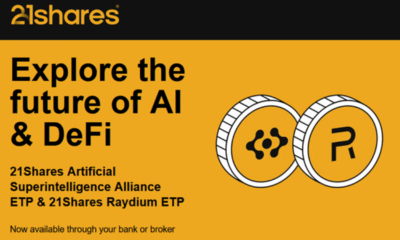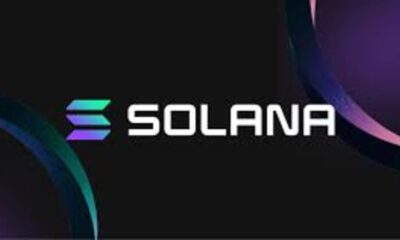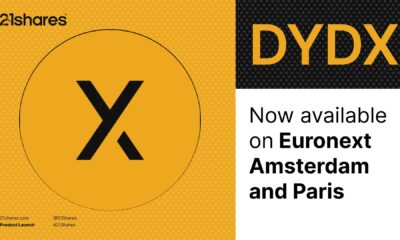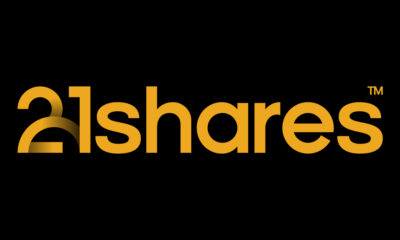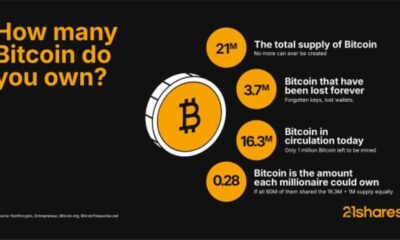Nyheter
Solana (SOL) Research Primer
Publicerad
2 år sedanden
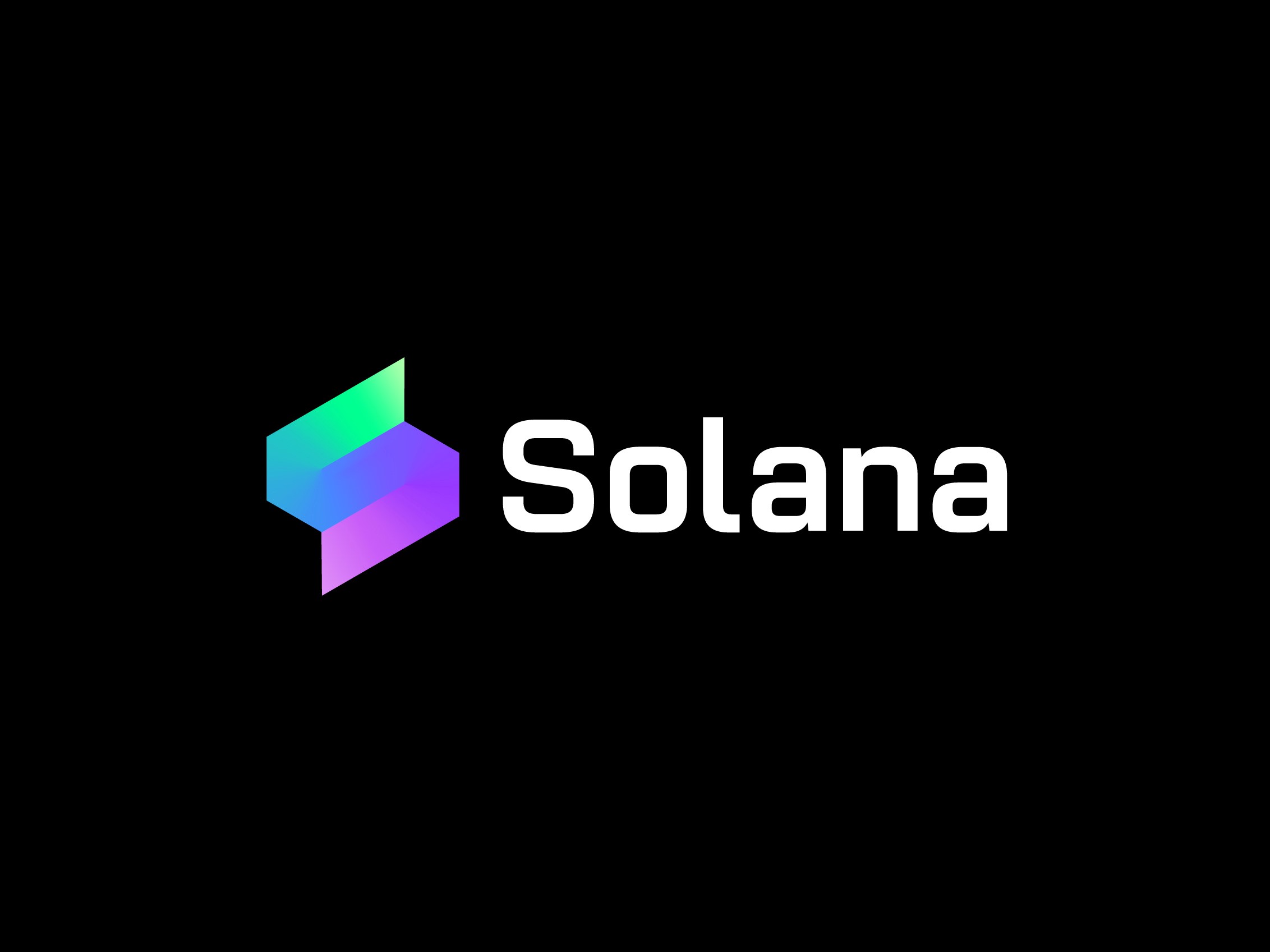
Solana (SOL) is a highly functional open source project that banks on blockchain technology’s permissionless nature to provide Decentralized Finance (DeFi) solutions. While the idea and initial work on the project began in 2017, Solana was officially launched in March 2020 by the Solana Foundation with headquarters in Geneva, Switzerland, headed by Anatoly Yakovenko.
Solana strives to improve the user experience of both builders and end-users with its novel consensus mechanism called Proof of History (PoH). PoH helps reduce network congestion, which has been a plague for decentralized blockchain in high usage times. The Solana blockchain is processing 1,000+ transactions per second vs. ~15 TPS for Ethereum. As a complement to Ethereum, Solana has one of the most vibrant communities and a noticeable developer activity with over 300 projects building decentralized financial services and crypto-native games, art — and audio streaming and media services on its platform.
In this report, 21Shares will offer an exhaustive overview of the Solana network, the SOL cryptoasset and discuss the various investment risks associated with Solana — in addition to how an investor can think about the future value of its underlying cryptoasset. Solana is one of the best-performing large-cap cryptoassets over the past months, and this report offers the most exhaustive coverage of Solana and SOL available on the market.
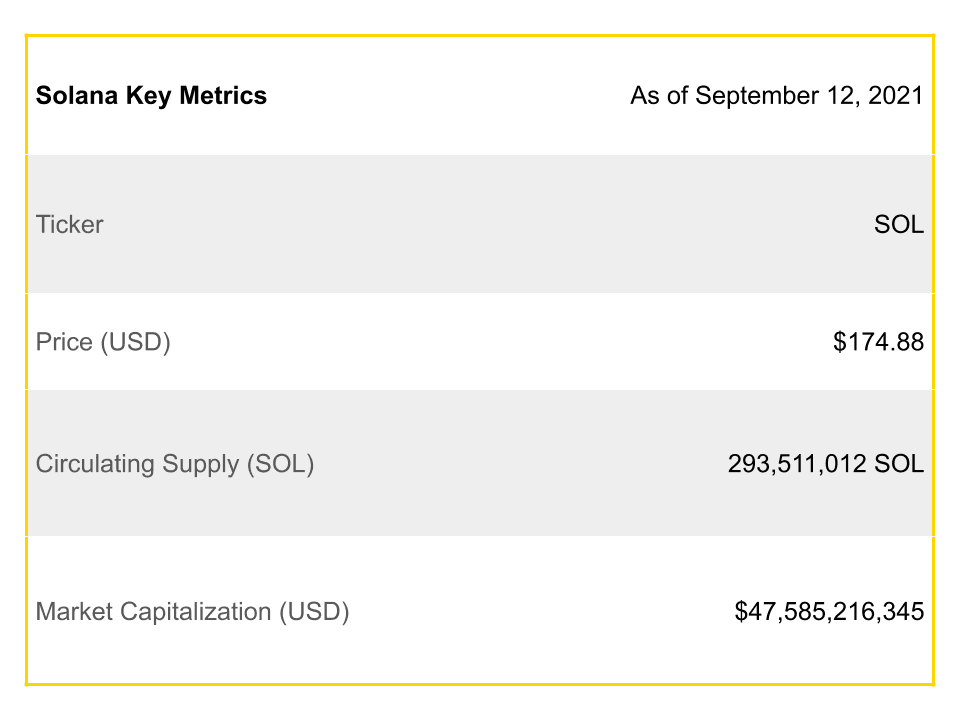
How Solana Works
This section will briefly outline how the Solana blockchain operates – including its consensus mechanism, how blocks are produced on its decentralized distributed network, and how it addresses issues prevalent on similar smart contract platforms such as Ethereum. Enjoying a high throughput of processing up to 50,000 transactions per second and block time generation of 400ms (0.4 seconds) puts the Solana network on par with highly proficient centralized systems. At the heart of those features is the network’s ability to provide means to reach consensus on a global clock without the need for substantial peer-to-peer messaging.
Proof of History (PoH)
Before settlements on the Ethereum blockchain, miners generally prioritize transactions from high to low transaction fees rather than their respective timestamp. As such, this leads to exclusions of transactions with relatively lower fees — and hence prices out microtransactions. Furthermore, given the open-source design of Ethereum, bots take advantage of market signals to prioritize their trades in a block in order to seize opportunities — such as timely participating in a token sale or an NFT auction. This concept is dubbed Miner Extractable Value (MEV) as transaction fees represent a portion of miners’ revenue alongside the block reward.
Solana’s Proof-of-History (PoH) aims to address this issue by establishing a trustless, secure source of time or a global clock preventing arbitrage based on transaction fees and time discrepancies amongst validators. Proof of History is an add-on protocol – not a consensus mechanism – that embeds the passage of time into the blockchain data structure as it constructs a chronological record of events. It can achieve this outcome as it is a high-frequency verifiable delay function (VDF). This algorithm dictates applying a set of consecutive steps for proper evaluation without parallel processing.
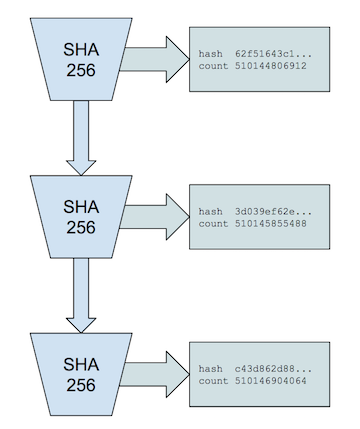
Source: Solana blog
Solana relies on a serialized reiterative algorithm, SHA-256, for hashing every transaction and documenting their chronological order. As such, processed transactions are both hashed and introduced as the input for the subsequent transaction. This concept is analogous to an old newspaper picture on a phone where one would be proving that the magazine originated before their device. As a result, the harmony around the time and order of the transactions expedites the time needed to verify them, as this process doesn’t require validator communication.
Tower Byzantine Fault Tolerance
An integral part of Solana’s consensus mechanism involves Tower Byzantine Fault Tolerance (BFT) that leverages PoH as the network’s global clock for reaching an agreement while preserving the properties of BFT and abstaining from synchronization on every block. The protocol ensures that network validators or nodes act in the network’s best interest by allowing up to one-third of faulty network nodes. Furthermore, the protocol keeps them in harmony by availing Proof of History as a cryptographic clock that bakes in vote lock-outs when validators go about voting for a particular fork.
Turbine
Another critical component that aids with the swift dispersion of data is the turbine protocol. Turbine is a block propagation protocol breaking down transactional data into smaller packets, invented by Solana and heavily influenced by the Bit-Torrent technology. It vastly improves the network’s processing capabilities as distributing copious amounts of data to all the nodes can be a significant hindrance. Solana’s architecture allows network leaders to break down blocks’ data into smaller packets, then broadcasted to a group of validators known as a neighborhood. They subsequently disseminate another portion of the data to the following neighborhood, and so on. A potential weakness can be the reluctance of a node to retransmit data; nonetheless, it is addressed with the relaying of erasure codes alongside the packets of data. This system helps increase the network capacity because it prevents dispersing whole copies of the ledger, thus allowing for higher transaction throughput.
Sealevel
Sealevel is Solana’s parallel smart contracts runtime. Most second-generation blockchains are single-threaded processors – indicating that only one smart contract can modify the state of the network at a time. This creates a bottleneck as the Ethereum Virtual Machine (EVM), for instance, inspects each transaction to ensure that it’s not at odds with one another. In addition, the EVM investigates the status of all account balances, whether of individuals or smart contracts, which are stored in the network’s state.
What Solana introduces is a hyper-parallelization transactional engine that can process up to thousands of smart contracts simultaneously. Since Solana’s transactions “specify the states a transaction will read or write while executing.” In that case, non-overlapping transactions found to be in the same state can be run concurrently without any issues, leading to higher network performance.
The SOL Token
The SOL token is the native currency of the Solana network. It has a maximum supply of ~ 489 million SOL, with a current circulating supply of 296 million. The currency functions as a utility token used for accessing services on the ecosystem and powering them, namely for paying transaction fees when issuing transfers or interacting with smart contracts. The SOL token can also be used in staking for generating rewards and eventually participating in on-chain governance.
The network strikes a balance between deflationary and inflationary models as it features a 7.7% rate of inflation attributable to staking. This rate is set to decrease by 15% annually until a long-term stable rate of 1.5% is reached. There is also a deflationary model through its token burning procedure for every issued transaction fee or through slashing. 100% of transaction fees are burned, but the figure is expected to decline to 50% to pay validators.
Governance and Treasury
The Solana Foundation, a Swiss non-profit organization, is expected to maintain possession of the network’s intellectual property and assist with the wider development of the blockchain with Solana Labs. Likewise, the latter is also expected to continue as a core contributor to the growth of the network.
As for when it comes to the token distribution, 16.23% of the total supply was allocated to seed sale, 12.92% for founding sale, 5.18% was directed for validator sale, 1.88% towards strategic sales, 1.64% meant for CoinList Auction, 12.74% for the team, 10.64% for the foundation, while 38.89% intended for community token distribution.
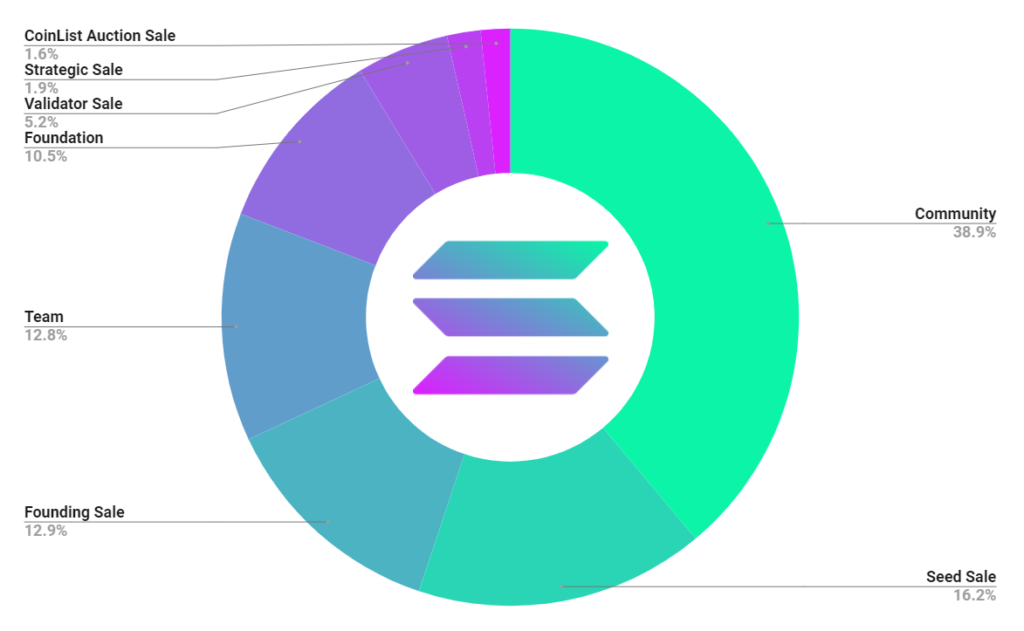
The State Of Solana
Anatoly Yakovenko published the Solana whitepaper in November of 2017 with the first open source prototype demonstrated in February of 2018. The success of the single node testnet was shortly followed by the release of the Multi-Node testnet mid-2018, illustrating the scalability capabilities of the Solana network. In 2019, on-chain programs, multi-region, multi-cloud and incentivized testnets were launched. Since the Mainnet launch in March 2020, continuous improvements and optimizations have been made to the network, increasing it’s stability and security.
Solana’s ICO raised $1.75 million at $0.22 in March 2020, as of September 2021 SOL recorded a growth of 795 times in value since its inception or +79,445.4%. From the initial ICO, the market capitalization of Solana has grown to $39 billion, ranking number 7 on Coingecko, with 8,543.7% YTD growth and a 24-hour trading volume of over $3 billion across various exchanges. The Total Value Locked (TVL) in Solana reached $8 billion by September 2021 with 34% dominance from Saber, one of Solana’s native decentralized exchange — the counterpart of Curve Finance. Comparing Solana’s development to other networks, current Solana TVL is equivalent to that of Ethereum in September 2020. As of writing, over 60% of Solana’s total value locked (TVL) emanates from three projects — two automated market makers (AMMs), Saber and Raydium and a yield aggregator, Sunny. At 21Shares, we expect cryptoassets to be staked across a greater number of projects with the rise of new financial services leveraging the Solana network.
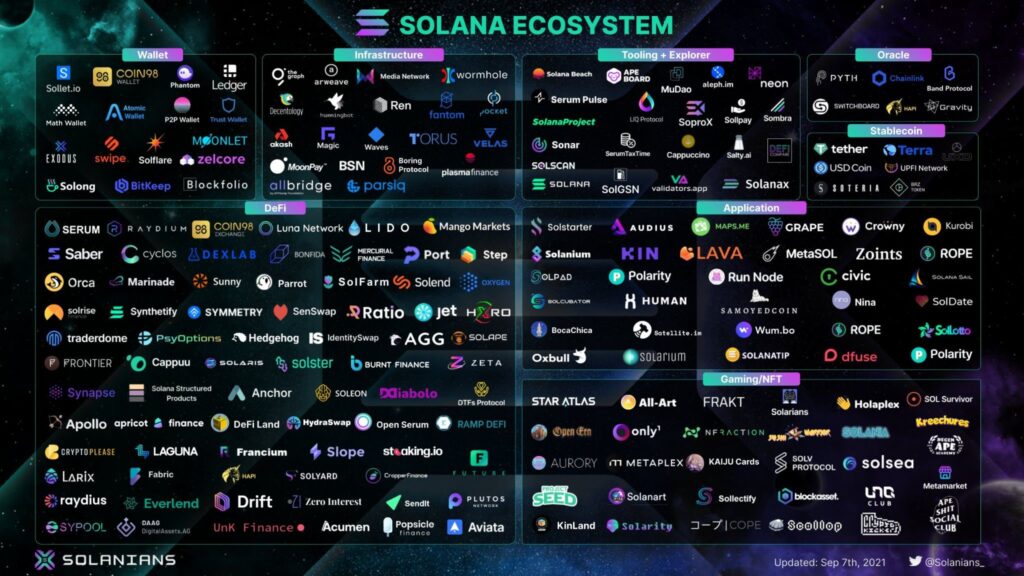
As of writing, the Solana network has recorded 30 billion transactions through a vibrant ecosystem composed of more than 360 applications in various sectors mainly decentralized financial services and crypto art and games. The use of Rust over EVM-compatible Solidity as the core programming language has been identified as one of the key constraints for developers building on Solana. To facilitate ecosystem growth, Solana foundation hosts annual hackathons. In the most recent event, there were 13,000 participants with 350+ project submissions, demonstrating the interest and strength of the growing community and continued developer support.
Reviewing Solana’s performance in the past year, the network has experienced significant and exponential growth. The value and rapid adoption of the network was reflected in the SOL price jumping by 199.8% in August 2021 alone outperforming the 50% YTD performance of Bitcoin. This growth has largely been attributed to various components: the viral launch of Degenerate Ape Academy in mid-August this year, high-yield incentives as well as the launch of multiple legitimate financial applications such as the DeFi yield aggregator, Sunny and the Solana-focused wallet, Phantom.
Technical Insights
This section will help you understand the major trade offs to build on Solana compared with Ethereum as the latter is the most dominant developer platform. Our engineering team gave their technical insights into Solana as a smart contract platform serving as an indication to the current state of Solana when it comes to building a vibrant and sticky developer community.
Summary:
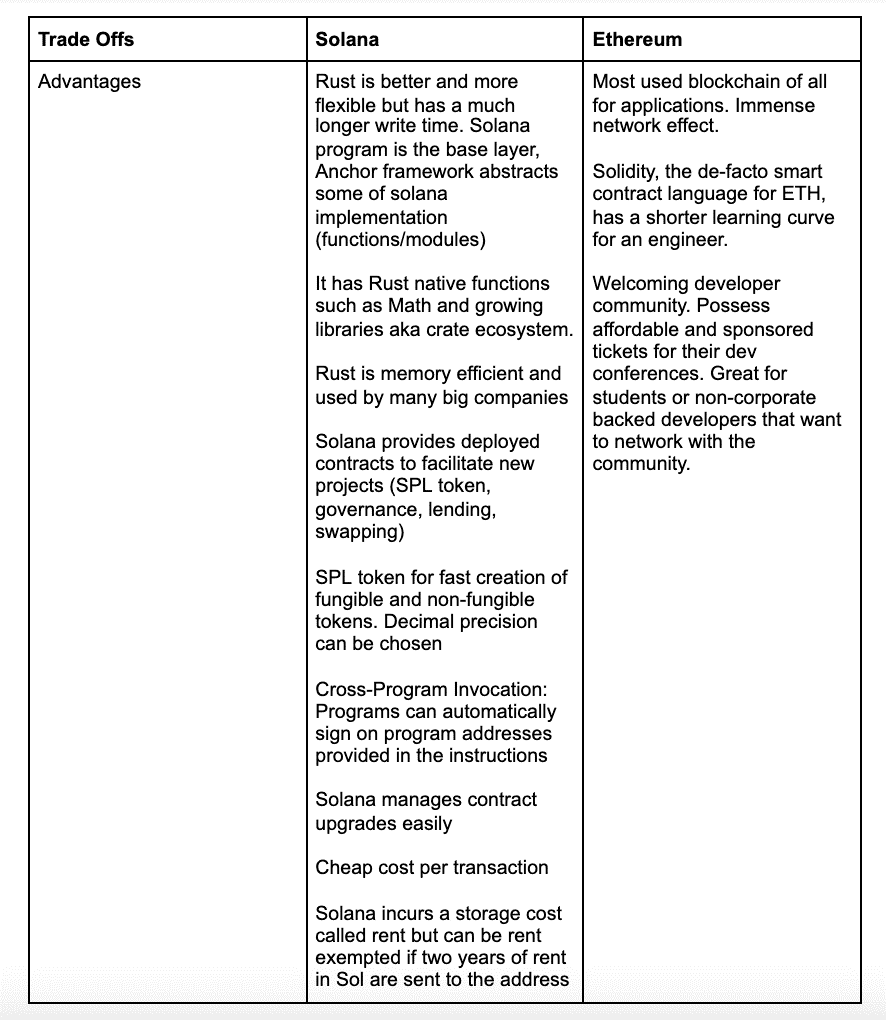
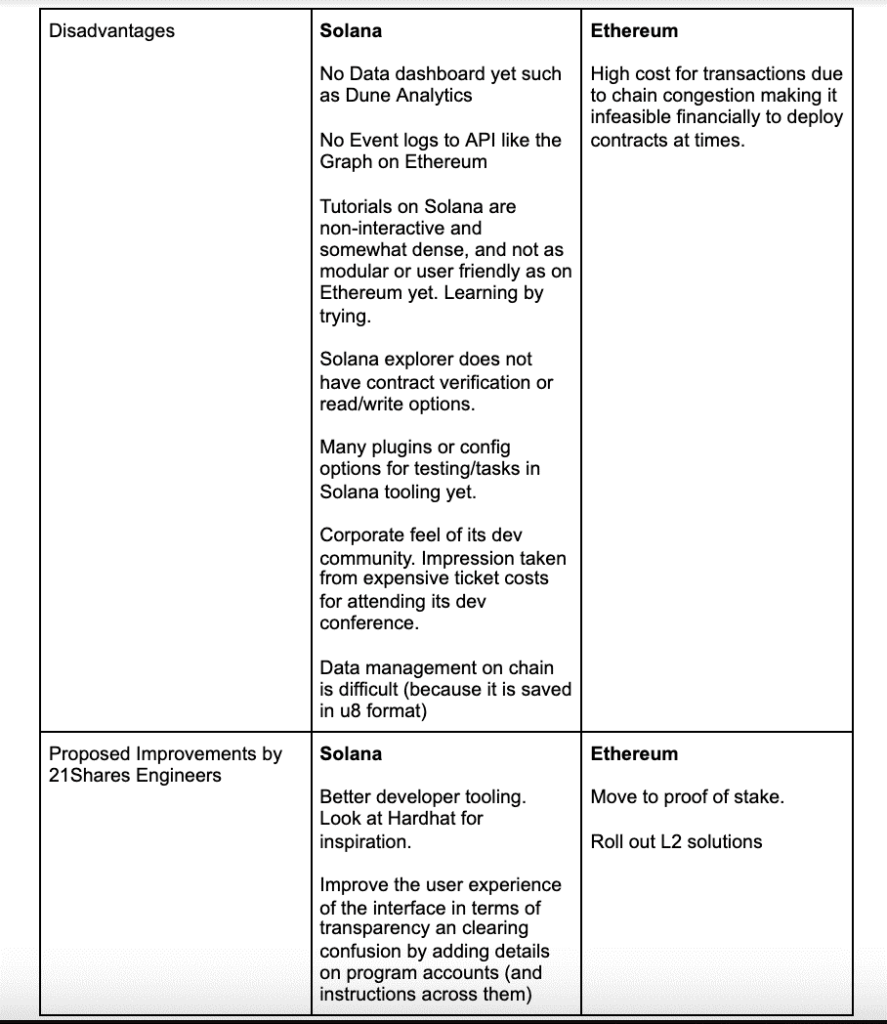
The Future of Solana
Solana’s network outlook appears to be exceptionally promising, especially with the latest round of private token sale funding ($340 million) led by Andreessen Horowitz and Polychain capital, joined with other notable venture capitalists like Alameda Research and CMS holdings. VC investments of such magnitude are typically indicative that a project showcases the fitting material for prosperity. The capital raising managed by Solana Labs will be used for the next developmental phase of ‘onboarding a billion users’. The funds will be directed at hiring the adequate engineers and staff necessary to power up the new innovations and develop the rising ecosystem through the efforts of Solana Labs. Amongst the planned products will be an incubation studio that aids with the bootstrapping of Solana-based projects, and a framework for simplifying capital raising investments. List will also include a dedicated trading desk for the ecosystem, paired with a venture investing arm.
Valuing Solana
There are two ways we can think of the potential value of Solana’s native asset, SOL. The first is carrying out a market sizing exercise to compare its value to that of its main competitors as its target market. Secondly, we can compare Solana’s current adoption — through the proxy of fees paid on the network — to that of Ethereum in order to understand if the current value of Solana can be justified whether there’s product-market fit.
Market Sizing
The chart below shows the current market capitalization of Solana, Polygon, Ethereum, and Bitcoin. Bitcoin and Ethereum represent what the market has judged as the current best use-cases of blockchain technology, specifically the smart contracts use case wherein Solana competes can be argued to be just as valuable in the long term. Binance, Terra and Polygon are networks that similarly experienced substantial growth in the first half of 2021 and serves as comparison for ecosystem development.
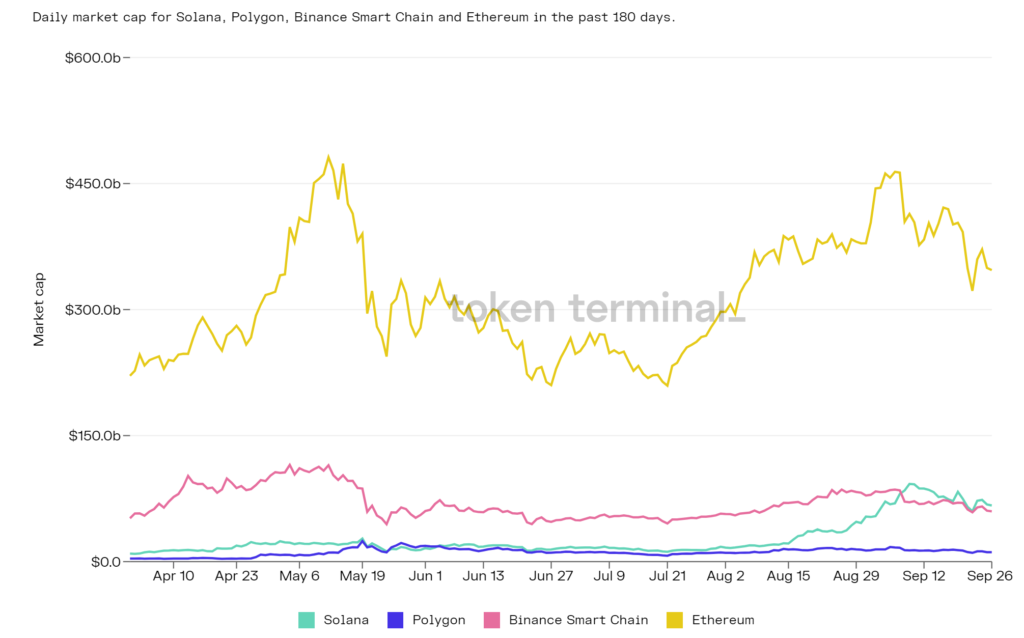
Total Value Locked
This section compares the current Total-Value-Locked (TVL) of Solana relative to other major networks such as Ethereum, Binance, Terra, Polygon and Bitcoin. TVL can be a useful tool to compare network utilization and a method to measure the flow of capital within DeFi.
At 21Shares, we explore metrics beyond price movements as markets tend to be forward-looking. For Ethereum competitors such as Solana, Avalanche, or Fantom, we assess the quality of user traction through the total value locked (TVL) in those platforms. These investments are poured into financial applications mainly native decentralized exchanges — the counterparts of Uniswap and Sushiswap: $8.73 billion in total for Solana, $3.14 billion for Avalanche, and $1.25 billion for Fantom. Solana is the fastest growing chain to reach the $1 billion mark in TVL in 95 days, 140 days for Fantom, and 199 days for Avalanche. However, when comparing the same TVL amounts of these networks against Ethereum indicates that Solana is likely undervalued — although other components can influence market sentiment and price developments like the unexpected outage for the Solana blockchain.
We can view the gross market value of Ethereum as the benchmark for the potential value that Solana could capture in the long term. If we do, we can see that Solana could easily capture at least 10 times more value from the existing DeFi applications to reach the current TVL of Ethereum — and this says little of the new value the platform will continue to create in the form of new areas such as art and gaming applications. Nonetheless, the L1 or smart contract vertical is highly competitive and will continue to be the case going forward. The Solana network will need to onboard more developers and creative artists to become the top venue where Solana-native and differentiated internet services are built or integrated before other networks.
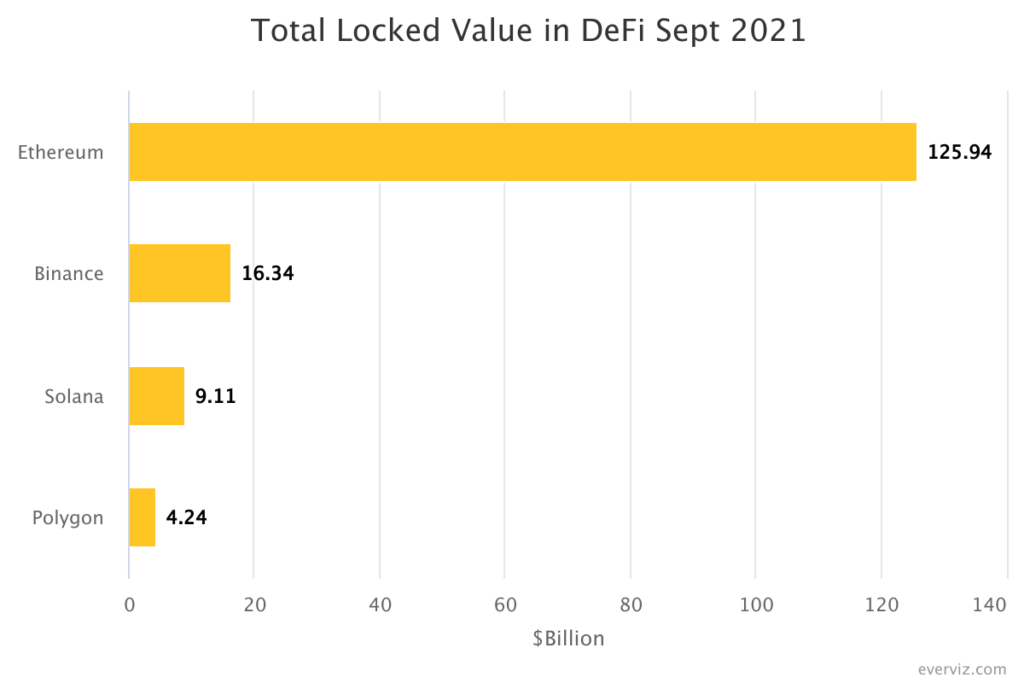
Total Value Locked in DeFi Sept 2021
Fees
Revenue generation is often a key metric when assessing network value. By assessing the total number of transactions and the average cost per transaction we are able to estimate the total revenue generated. Fees are a good signal for the overall demand for a given smart contract platform and arguably the strongest barometer of fundamental growth. Solana’s 30 billion transactions with the average cost of $0.00025 gives an estimated revenue of $7.5 million since the launch of the mainet in March 2020. Ethereum’s annualized revenue stands at $13.32 billion.
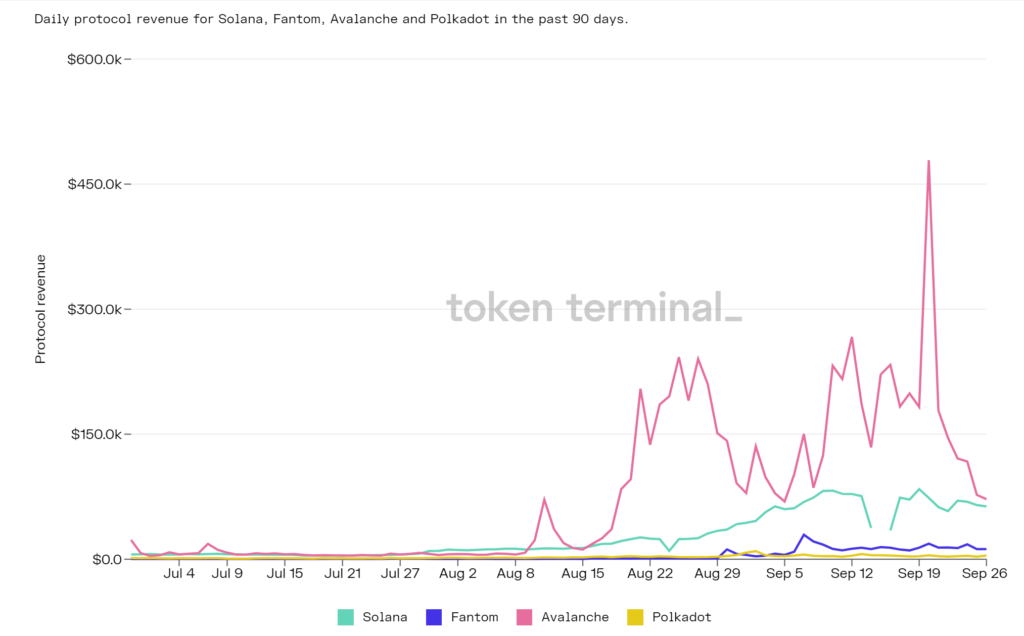
Price-to Sales (P/S) Ratio compares a protocol’s market cap to its revenues. This metric is particularly useful for early-stage protocols where income is often reinvested into growth. A low ratio could imply that the protocol is undervalued and vice versa. An evaluation of historic P/S ratio against its market cap can also demonstrate the consistency of fees and revenue.
Figure 1 indicates the P/S ratio for other Layer 1s in comparison to Solana.
This metric indicates Solana’s network is still in its infancy when compared to Ethereum, it is clear there is room for growth and value generation as the ecosystem develops and greater user adoption.
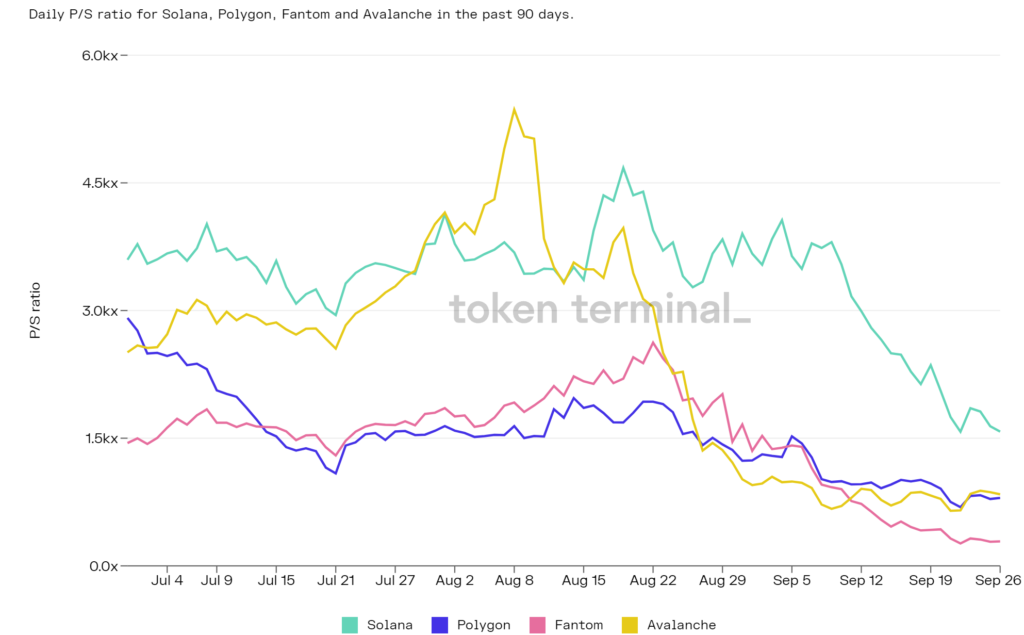
Risks
Technological risks
One of the impediments potentially undermining the decentralization of the blockchain relates to the immoderate expenses for running a solana validator node. Minimum hardware requirements vital for operating a node are estimated to cost somewhere between 3000-5000 dollars – for procuring high-end CPU, as validators would be expected to feature machinery locked-in with at least 128 GB of RAM memory, motherboard with at least 256 GB capacity, and a CPU with 24 threads. In other words, aspiring nodes would be looking at acquiring hardware with high-end specs that aren’t affordable for average retail consumers, as when comparing the economic hardware specs required for running an ethereum mining node. Solana’s rebuttal to the challenge is that hardware will persistently improve, on the basis of Moore’s law, resulting gradually in cheaper equipment and thereby lowering the barrier of entry towards the more average consumer.
Another potential delicacy arises from the semi-centralized structure of network leaders that allows the network to achieve its high-transaction throughput. Rather than relying on nodes cross-communicating to ensure they’re synchronized before proceeding to validate transactions, Solana features a network leader tasked with producing a proof-of-history sequence that guarantees a distinctive global order of transactions for efficient processing by the validators. Subsequently, transactions are then broadcasted to validators adjoined with a signature of the final state that manifests the leader’s identity via his public key. A tenable drawback of this system is empowering central leaders to censoring transactions and votes. That’s why leaders rotate every 4 blocks, or 1.6 seconds.
A final telling critique of the network concerns the concentration of stake in the hands of a few entities, commonly found in similar PoS blockchains. At the time of the writing, almost 2% of the network’s active validators (17 out of 845) own about ⅓ of the stake – minimum required to halt the network. However, as the network permits for stake delegation – designed for smaller entities hoping to generate a yield by consigning their tokens to bigger validators with capable hardware, Solana has been trying to address the predicament with several solutions. First is the Stake-O-Matic delegation matching program whereas the solana foundation incentivizes stake delegation towards smaller nodes to optimize for decentralization. Another is an automated delegation strategy where a pool of 100 million SOL tokens get systematically distributed amongst a larger number of validators to boost the amount of nodes forming 33% of the global stake, aiming for hardening the network’s security.
In late September this year, the Solana network went into a grinding halt triggered by the blockchain’s inability to produce new blocks for almost 17 hours. Even though the official technical post-mortem hasn’t been released yet, as of writing, the network appears to have encountered a malicious Denial-of-Service attack (DOS). This attack was caused by trading bots aiming to venture into snipping the new Initial DEX Offering (IDO) of the Grape project launching on top of Raydium protocol, the Uniswap’s counterpart on the Solana ecosystem. The preliminary technical overview provided by the Solana Foundation explained that the explosive bot activity exceeded the network’s capacity of 50K transactions per second to reach 400K transactions per second. This induced the network to produce multiple forks of itself, meanwhile subsequently forcing nodes to go offline as they couldn’t agree on the network’s correct state. The network had since come back online following Anatoly’s calls to coordinate efforts and amongst the validators across Discord and Twitter.
Notable about this development is the vitality of battle-testing contemporary technologies such as Solana. It is now clearer that the theoretically-superior processing capabilities of the blockchain need to be revisited as 50,000 tx/s will not cut it for the network if it would really aim to target the market-share for platforms such as Nasdaq, and seek to onboard over a billion users.
Adoption risks
Contrasting with comparable layer 1 smart-contract based networks, Solana’s blockchain is not EVM compatible, meaning that ETH-based dApps cannot directly run on top of the network’s operating system. Solana’s architecture irreconcilability warrants Ethereum’s dApps looking to migrate over to be reassembled from the ground-up. Alternatively, the network allows for developing smart contracts using the Rust programming language, which despite its offering of superior capabilities in designing faster and more durable applications, is still a young programming language within the industry. That could prove a challenge towards the adoption of Solana as it hampers in benefiting from Ethereum’s network effects and espousing the portability of the crosschain-verse we’re gravitating towards. Be that as it may, a number of private solutions are emerging on the market such as Neon EVM – a mediator virtual machine allowing for the running ETH smart contracts on top of Solana – which is piloted on the network’s testnet.
Regulatory risks
In character with similar layer 1 blockchains, Solana was bankrolled through 4 private funding rounds commencing in March of 2018, and culminating with the public ICO held in March of 2020. The network’s mainnet beta was launched shortly after the public ICO, showcasing simple transactional capabilities alongside means of deploying smart contracts. As discussed, The SOL token can be consumed to pay for transaction fees combined with passive income generated through its staking mechanism. Now while it can be argued that SOL was originally a security offering as token holders were reaping the benefits of its price appreciation merely from the efforts of the developmental team and the marketers, the token’s beta mainnet – acting as the fully functioning underlying network, is already onboarding a plurality of financial, art and gaming applications launching on top of it. That is to say that one will need to pay with SOL to access the services of those Dapps similar to how interacting with DeFi on the Ethereum network is managed. Thus, the ecosystem’s growth paired with further decentralized governance of the network — once it reaches a reasonable maturity phase where it is self-standing without the involvement of Solana Labs’ efforts could help in stipulating the asset as a non-security and fend-off legal scrutiny.
Disclaimer
This report has been prepared and issued by 21Shares AG for publication globally. All information used in the publication of this report has been compiled from publicly available sources that are believed to be reliable. However, we do not guarantee the accuracy or completeness of this report. Crypto asset trading involves a high degree of risk. The crypto asset market is new to many and unproven and may have the potential to not grow as expected.
There is currently relatively little use of crypto assets in the retail and commercial marketplace compared to relatively large use by speculators, thus contributing to price volatility that could adversely affect an investment in crypto assets. In order to participate in the trading of crypto assets, you should be capable of evaluating the merits and risks of the investment and be able to bear the economic risk of losing your entire investment.
Nothing in this email does or should be considered as an offer by 21Shares AG and/or its affiliates to sell or solicitation by 21Shares AG or its parent of any offer to buy bitcoin or other crypto assets or derivatives. This report is provided for information and research purposes only and should not be construed or presented as an offer or solicitation for any investment. The information provided does not constitute a prospectus or any offering and does not contain or constitute an offer to sell or solicit an offer to invest in any jurisdiction.
Readers are cautioned that any such forward-looking statements are not guarantees of future performance and involve risks and uncertainties and that actual results may differ materially from those in the forward-looking statements as a result of various factors. The information contained herein may not be considered as economic, legal, tax, or other advice and users are cautioned against basing investment decisions or other decisions solely on the content hereof.
Du kanske gillar
Nyheter
HANetf och Infrastructure Capital Advisors samarbetar för att lansera aktivt förvaltad preferensavkastnings-ETF i Europa
Publicerad
14 timmar sedanden
18 september, 2025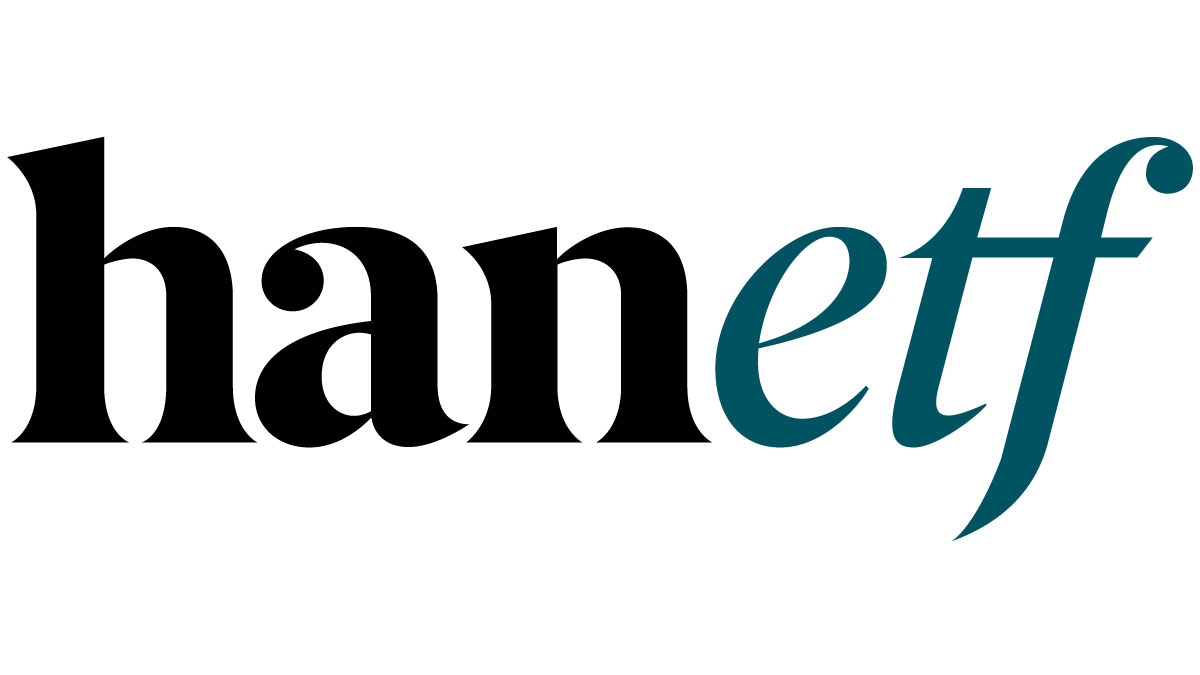
- HANetf har lanserat Infrastructure Capital Preferred Income UCITS ETF (ticker: ASWN).
- ETFen investerar huvudsakligen i en portfölj av preferens-, hybrid- och inkomstgenererande värdepapper utvalda av de aktiva förvaltarna.
- ETFen syftar till att maximera intäkterna och utnyttja strategiska möjligheter till kapitaltillväxt på medellång till lång sikt.
- Detta är den 14e aktiva ETFen på HANetf-plattformen.
- Detta är den första aktiva preferensavkastnings-ETFen i Europa.
- ETFen är noterad på Xetra, följt av London Stock Exchange och Borsa Italiana.
HANetf, Europas första och ledande white-label UCITS ETF och ETC-plattform, är glada att kunna meddela lanseringen av Infrastructure Capital Preferred Income UCITS ETF (ticker: PFFI) på Deutsche Borse Xetra.
ETF-fonden tillämpar en aktivt förvaltad avkastningsstrategi, främst inriktad på amerikanska preferensaktier, och är utformad för att leverera hög löpande avkastning genom en diversifierad portfölj av inkomstgenererande värdepapper.
Den strävar efter att överträffa traditionella riktmärken för preferensaktier genom att kombinera rigorös kvantitativ screening med kvalitativt värdepappersurval. Denna metod betonar värdepapper som rådgivaren anser är undervärderade baserat på faktorer som kredit- och löptidspremie, likviditet, sektorexponering och börsvärde.
Genom aktiv förvaltning syftar ETF:n till att utnyttja prissättningsineffektiviteter till följd av ränteförändringar, kreditrisk och marknadsförändringar – vilket ger investerare exponering mot ett bredare utbud av högavkastande möjligheter än vad som vanligtvis finns i passiva inkomstfonder.
ETFen betalar ut en hanterad månatlig utdelning, vilket gör det möjligt för investerare att generera regelbunden inkomst som kan återinvesteras eller omfördelas. Denna funktion, i kombination med rådgivarens förmåga att reagera dynamiskt på förändrade marknadsförhållanden, gör ETF:n potentiellt attraktiv för investerare som söker avkastning i dagens lågräntemiljö.
ETF:n förvaltas av ett erfaret investeringsteam från Infrastructure Capital Advisors, ett finansiellt boutiqueföretag med över 2,5 miljarder dollar i förvaltade tillgångar.
VD och IT-chef Jay Hatfield, vars ekonomiska analys nyligen citerades av USA:s president, har årtionden av erfarenhet inom energiinfrastruktur och kapitalmarknader, efter att ha arbetat som portföljförvaltare på SAC Capital och som investeringsbankir på Morgan Stanley och CIBC Oppenheimer, där han ledde transaktioner för över 10 miljarder dollar.
Samuel Caffrey-Agoglia, företagets finansdirektör och CRO, bidrar med djupgående juridisk, redovisnings- och regulatorisk expertis, med en bakgrund som inkluderar roller på PwC, det amerikanska energidepartementet och en advokatbyrå i New York.
Andrew Meleney, forskningschef och portföljförvaltare, är en CFA Charterholder med erfarenhet av att analysera avkastningsinvesteringar, mellanstora MLP:er samt energi- och infrastruktursektorer.
ETF:en är den 14:e aktiva ETF:en på HANetf-plattformen, efter en hög volym lanseringar de senaste månaderna. Aktiva ETF:er i Europa såg en ökning med mer än 37 % i förvaltat kapital (AUM) från första till andra kvartalet 2025, efter en ökning med 68 % förra året – vilket visar den växande efterfrågan på aktiva strategier.
ETFen kommer att noteras på London Stock Exchange och Borsa Italiana så småningom.
Jay Hatfield, VD och IT-chef på Infrastructure Capital Advisors, kommenterade:
”Vi är glada över att kunna lansera vår föredragna inkomststrategi på de globala marknaderna. Vi tror att det är en lämplig tidpunkt för globala investerare att investera i högre avkastning i takt med att räntorna faller globalt. Vi tillämpar vår omfattande investeringsprocess på PFFI, som är centrerad kring riskhantering.
”Vi är glada över att samarbeta med HANetf och tror att teamet erbjuder innovativa investeringsprodukter så att investerare kan diversifiera sina portföljer och dra nytta av olika marknadsmiljöer.”
Hector McNeil, medgrundare och VD för HANetf, kommenterade: ”Vi är glada över att samarbeta med Infrastructure Capital Advisors för att lansera Infrastructure Capital Preferred Income UCITS ETF (ticker: PFFI). ETFen är utformad för att göra det möjligt för investerare att generera regelbunden inkomst, som sedan kan återinvesteras eller omfördelas – i en tid då investerare i allt högre grad söker pålitlig inkomst och smartare sätt att navigera på volatila marknader. Med Infrastructure Capitals forskningsdrivna aktiva förvaltningsprocess anser vi att denna fond erbjuder ett övertygande alternativ till traditionella passiva inkomststrategier – den ger flexibiliteten att fånga attraktiva avkastningsmöjligheter samtidigt som den hanterar nedåtrisken.
”Detta är den 14:e aktiva ETFen på HANetf-plattformen, och den kommer mitt i en allt större mängd förfrågningar från kapitalförvaltare om att lansera aktiva strategier hos oss. Det aktiva området växer snabbt i Europa och visar inga tecken på att sakta ner inom den närmaste framtiden. Vi ser fram emot att utöka vårt aktiva utbud med både nya och befintliga partners.”
Infrastructure Capital Preferred Income UCITS ETF (PFFI)
TER: 0.80%
ISIN: IE0008LRGGP4
Nyheter
Palantir är upp 125 % i år. Apple är ner 5 %.
Publicerad
15 timmar sedanden
18 september, 2025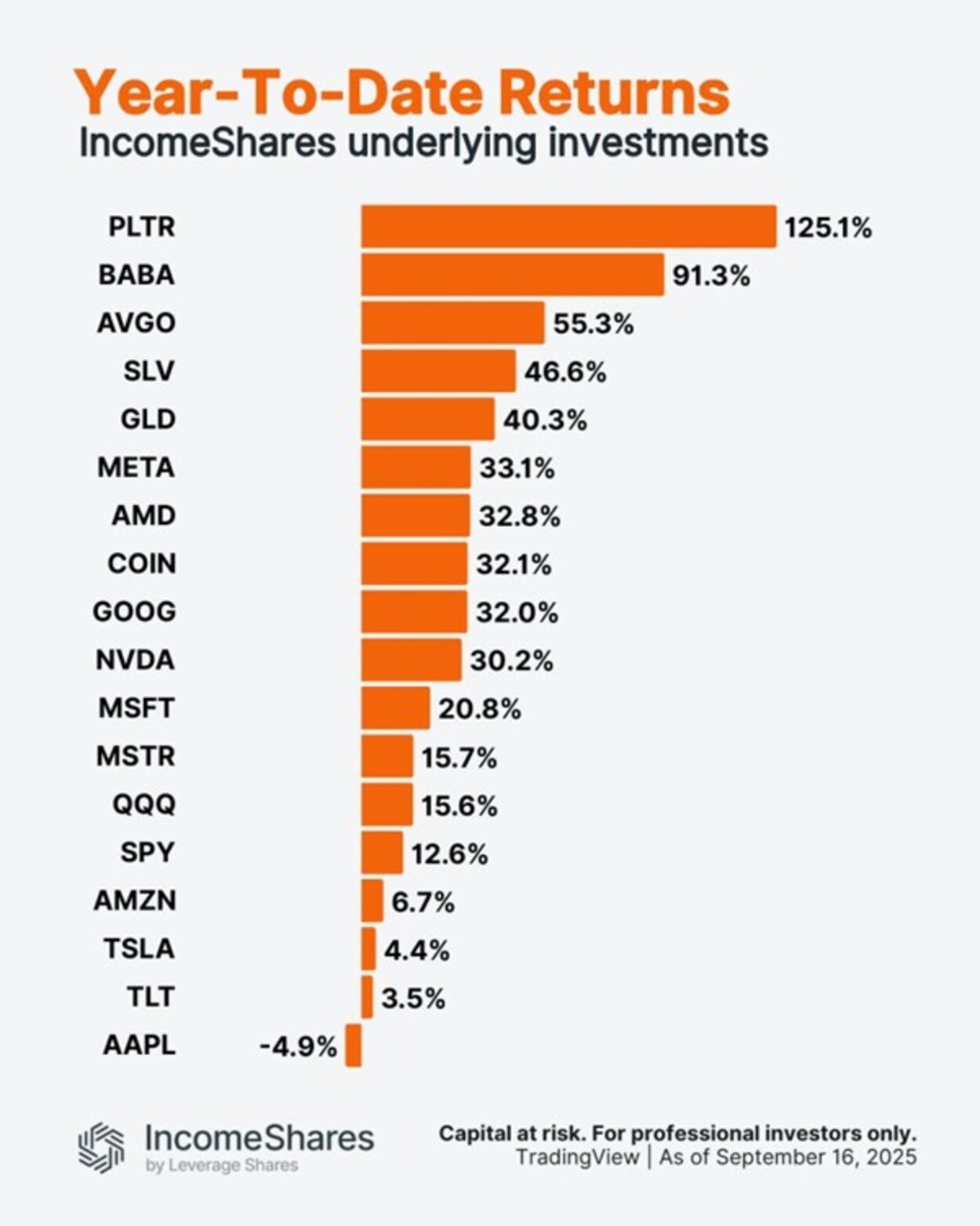
Diagrammet visar hur varje underliggande investering som används i IncomeShares-produkter har presterat hittills under 2025 – från stora teknikvinnare till långfristiga statsobligationer.
IncomeShares börshandlade produkter säljer optioner på dessa underliggande investeringar i syfte att generera månatlig inkomst, samtidigt som de har exponering mot deras prisrörelser.
Följ IncomeShares EU för marknadsinsikter.
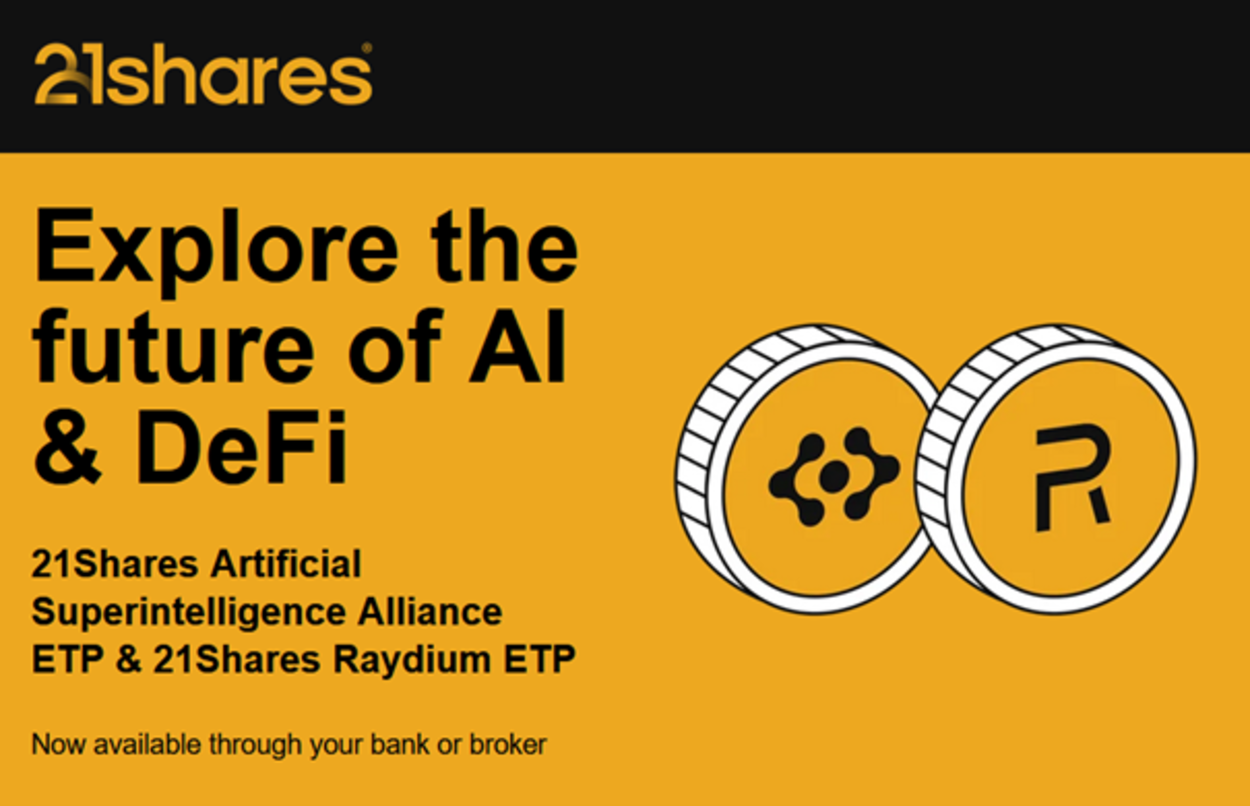
På 21Shares tror vi på att ge investerare tidig och enkel tillgång till de mest transformerande trenderna inom krypto. Idag är vi stolta över att presentera två nya produkter som fångar framtiden för AI och DeFi, och med dem firar vi en viktig milstolpe: 50 börsnoterade produkter i EMEA, vilket gör oss till en av de största utgivarna av krypto-ETP:er sett till bredden av erbjudandet.
21Shares Artificial Superintelligence Alliance ETP (ticker: AFET) ger investerare likvid exponering mot världens största decentraliserade AI-ekosystem. Det banbrytande teamet bakom Artificial Superintelligence Alliance bygger ett öppet och skalbart AI-nätverk utformat för att bryta Big Techs grepp om artificiell intelligens och frigöra fördelarna med decentraliserat ägande.
21Shares Raydium ETP (ticker: ARAY) ger investerare exponering mot Solanas ledande decentraliserade börsprotokoll – Raydium. Raydium kombinerar djup likviditet, intäktsmodeller med flera strömmar och innovativ tokenomik med en växande roll i tokeniseringen av verkliga tillgångar – och positionerar sig som en hörnsten i Solanas DeFi-ekosystem.
Med AFET och ARAY kan du nu få tillgång till två sektorer i framkant av blockkedjeinnovation direkt via din bank eller mäklare.
Läs mer om möjligheterna bakom våra nyaste ETP:er och deras investeringsteorier.
Produktinformation 21Shares Artificial Superintelligence Alliance ETP
| Namn | 21Shares Artificial Superintelligence Alliance ETP |
| Kortnamn | AFET |
| ISIN | CH1480821375 |
| Valuta | USD, EUR |
| Börs | Euronext Amsterdam and Paris |
| Avgift | 2,50 % p.a. |
Produktinformation 21Shares Raydium ETP

HANetf och Infrastructure Capital Advisors samarbetar för att lansera aktivt förvaltad preferensavkastnings-ETF i Europa

Palantir är upp 125 % i år. Apple är ner 5 %.

Utforska framtiden för AI och DeFi

ONCC ETP spårar den schweiziska dagslåneräntan

HANetf kommenterar kopparuppgången

Utdelningar och försvarsfonder lockade i augusti

Månadsutdelande ETFer uppdaterad med IncomeShares produkter

HANetfs analyserar hur ett fredsavtal kan påverka det europeiska försvaret

ADLT ETF investerar bara i riktigt långa amerikanska statsobligationer

Septembers utdelning i XACT Norden Högutdelande
Populära
-

 Nyheter3 veckor sedan
Nyheter3 veckor sedanUtdelningar och försvarsfonder lockade i augusti
-

 Nyheter4 veckor sedan
Nyheter4 veckor sedanMånadsutdelande ETFer uppdaterad med IncomeShares produkter
-

 Nyheter4 veckor sedan
Nyheter4 veckor sedanHANetfs analyserar hur ett fredsavtal kan påverka det europeiska försvaret
-

 Nyheter4 veckor sedan
Nyheter4 veckor sedanADLT ETF investerar bara i riktigt långa amerikanska statsobligationer
-

 Nyheter2 veckor sedan
Nyheter2 veckor sedanSeptembers utdelning i XACT Norden Högutdelande
-

 Nyheter4 veckor sedan
Nyheter4 veckor sedanFastställd utdelning i MONTDIV augusti 2025
-

 Nyheter2 veckor sedan
Nyheter2 veckor sedanHANetf kommenterar mötet mellan Kina, Ryssland och Nordkorea vid militärparad
-

 Nyheter4 veckor sedan
Nyheter4 veckor sedanAICT ETF investerar i obligationer utgivna av företag från tillväxtmarknader


